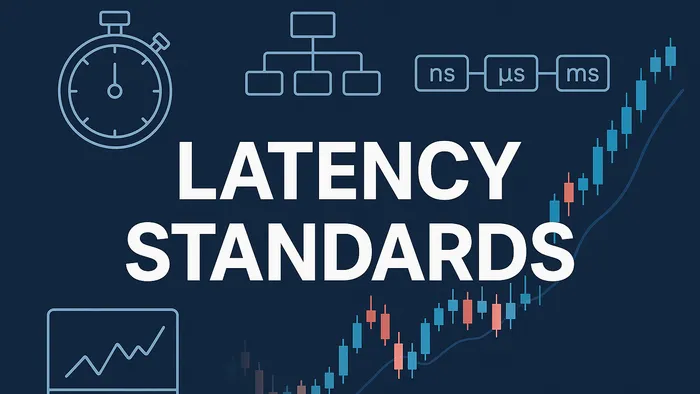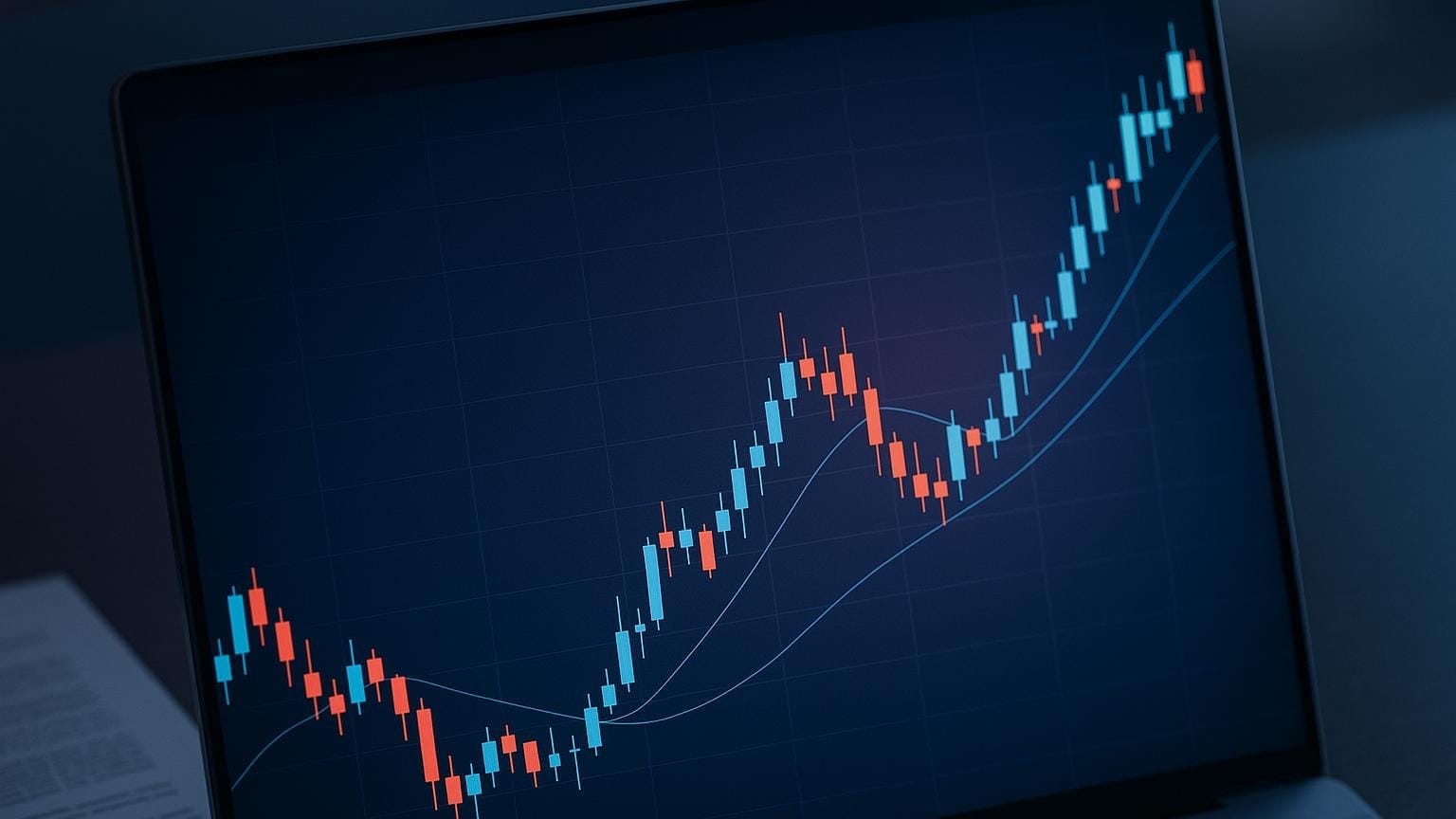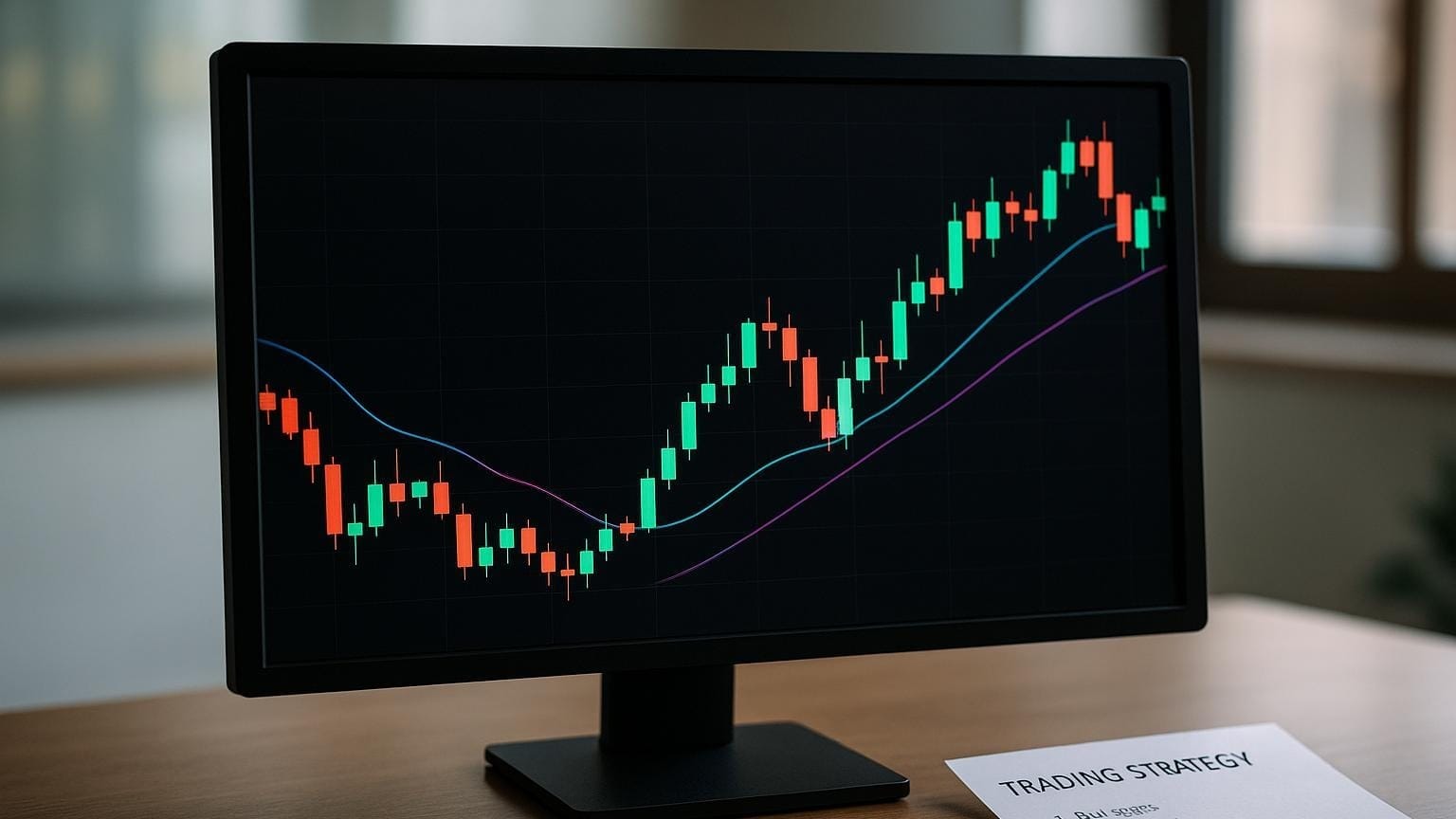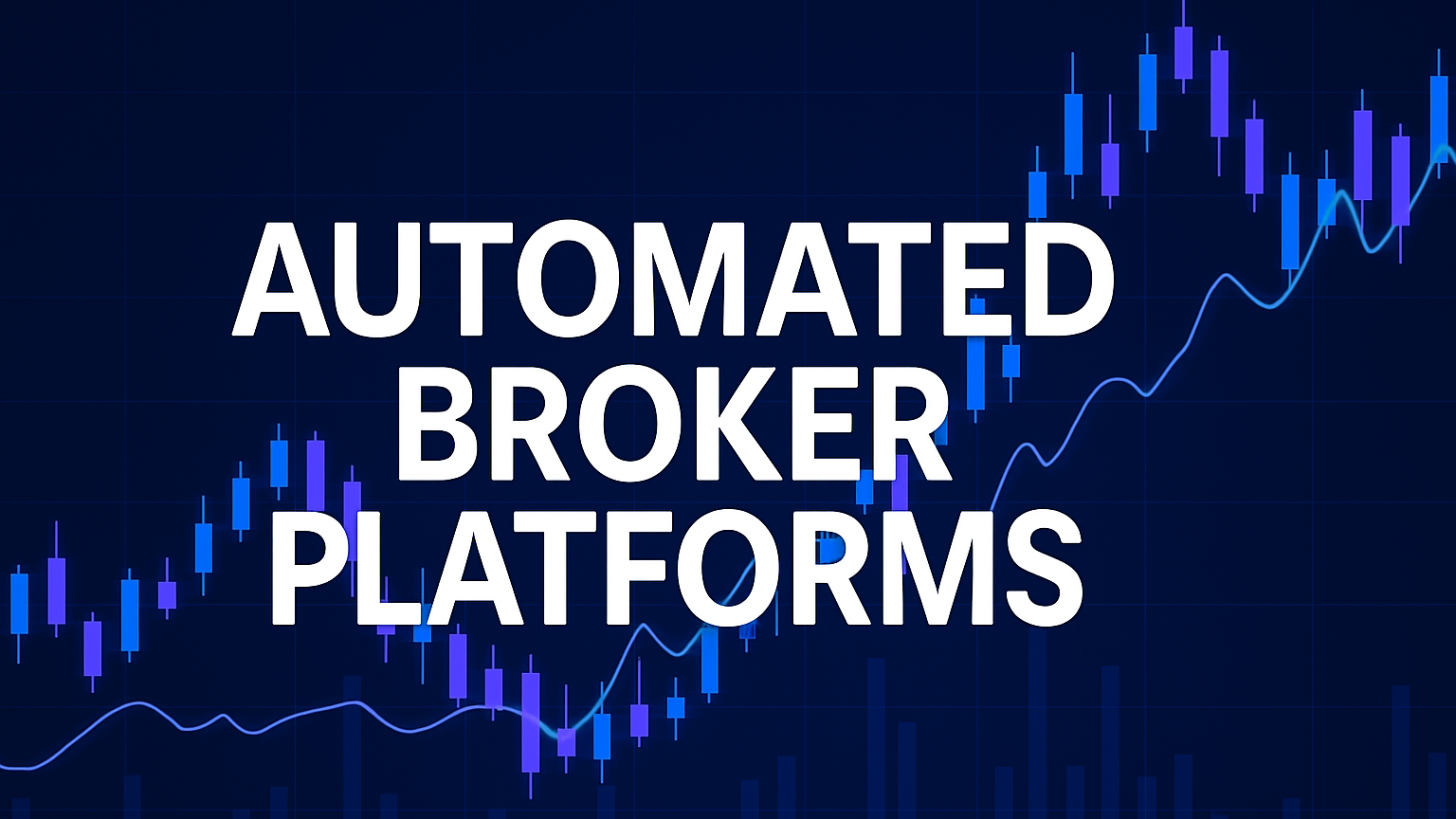Explore the critical role of latency in trading systems and its impact on profitability, execution speed, and market competitiveness.
Trading latency matters. Even a 1-millisecond delay can cost large firms millions annually. Latency optimization ensures faster trade execution, better pricing, and reduced slippage.
Key Takeaways:
- What is Latency? The time delay between initiating and executing a trade.
- Why It’s Important: Low latency = competitive edge in high-frequency trading.
- How It’s Measured: Milliseconds (ms), microseconds (µs), and nanoseconds (ns).
- Main Factors: Market data speed, order speed, and network efficiency.
- Standards: High-frequency equities require latency under 100ms; retail stocks and Forex tolerate 100–300ms.
- Optimization Methods: Use co-location, direct exchange feeds, advanced hardware, and optimized software.
Quick Comparison of Latency Units:
| Unit | Scale | Example |
|---|---|---|
| Milliseconds (ms) | 1/1,000 second | Standard for most systems |
| Microseconds (µs) | 1/1,000,000 second | NYSE to Nasdaq: 180µs |
| Nanoseconds (ns) | 1/1,000,000,000 second | Cutting-edge trading tech |
Low latency isn’t just a technical goal - it’s essential for profitability in today’s financial markets.
Low-Latency Programming and High-Frequency Trading Masterclass
Main Latency Components
Trading system latency depends on three main factors. By breaking these down, traders and developers can fine-tune their systems for better performance.
Market Data Speed
This refers to the time it takes for market data to travel from its source to a trading system. Ultra-low latency systems measure this in microseconds, reflecting the need for extreme speed in modern trading . Here's how market data speed influences order activity, based on SEC research:
| Time Window | Order Activity |
|---|---|
| < 500 microseconds | Fewer than 8% of cancellations |
| < 50 milliseconds | 25% of cancellations, 20% of trades |
| < 0.5 seconds | 38.7% of canceled orders |
| < 5 seconds | Over 33% of orders remain active |
These numbers underscore the importance of processing market data quickly and accurately, especially as the volume of real-time data continues to grow.
Order Speed
Order speed determines how fast trades can be executed, directly affecting pricing and competitiveness. Nearly all orders are either canceled or executed within 10 minutes . Notably, 27.2% of trades are executed when participants act on posted orders within just half a second .
Key aspects include:
- Rapidly responding to stock price changes
- Securing the best available prices for trades
- Maintaining reliable performance under different market conditions
Network Speed
Network efficiency plays a major role in reducing latency. Using direct exchange feeds can cut transmission time by 150 to 500 milliseconds . For day traders, a stable connection is critical, with a recommended minimum of 25 Mbps download and 3 Mbps upload speeds. Professional setups often aim for latency under 20 milliseconds .
To minimize network delays, organizations often rely on:
- Co-location services: Hosting servers within exchange data centers
- Direct connections: Favoring wired Ethernet over wireless setups
- Advanced hardware: Using specialized switches and routers
- Backup systems: Ensuring reliability with uninterruptible power supplies
These measures collectively define the latency benchmarks crucial to trading systems.
Market Latency Standards
Latency requirements differ based on the type of asset and trading strategy, with advancements in technology continuously tightening these expectations.
Asset-Specific Standards
Each asset class has its own latency expectations to ensure effective trading. Here's a quick breakdown:
| Asset Type | Recommended Latency | Trading Impact |
|---|---|---|
| High-Frequency Equities | Under 100 ms | Crucial for staying competitive in price execution |
| Forex | 100–300 ms | Works well for most algorithmic trading strategies |
| Retail Stocks | 100–300 ms | Adequate for retail traders; higher latency risks slippage |
Fiber optic cables, for instance, transmit signals at about 4.9µs per kilometer . These latency needs are shaped not only by the asset type but also by the trading strategy in play.
Strategy-Based Standards
Latency requirements also depend on the trading strategy. High-frequency trading (HFT) strategies, for example, demand latency under 100 ms. In contrast, other algorithmic strategies can function effectively within a 100–300 ms range. To illustrate, in the interbank market, Bank A updates its quotes every 50 ms, while Bank B operates at 250 ms. This faster update rate gives Bank A a clear edge .
As market dynamics evolve, these latency benchmarks continue to shift, reflecting the need for faster and more efficient systems.
Standards Timeline
Technological progress has consistently pushed latency benchmarks lower. Tony Jones, Head of Low Latency Strategy at BSO, explains:
"The last five years have seen remarkable changes, primarily driven by hardware improvements such as routers, switches, and advancements in fiber optics."
Some key advancements include:
- Physical Infrastructure: Improvements approaching the speed-of-light limit (299,792,458 m/s) .
- Co-location Services: Hosting servers directly within exchange facilities for reduced delays.
- Network Optimization: Better routing technologies for faster data transmission.
Today's trading systems are built for increasingly shorter latency windows. What was considered fast a decade ago is now outdated, as even nanoseconds can make a big difference in modern markets .
Latency Reduction Methods
Reducing latency in trading systems requires fine-tuning hardware, software, and network configurations. By focusing on these areas, you can achieve faster and more efficient operations, which are crucial in competitive trading environments.
Hardware Setup
Using specialized hardware is critical for low-latency trading. SmartNICs, such as Cisco Nexus SmartNICs, have shown significant performance gains, offering up to 10x better latency compared to standard network interface cards .
Here’s a breakdown of some top hardware solutions:
| Component | Features | Performance Impact |
|---|---|---|
| AMD Alveo™ X3 Series | 4x 10/25 GbE ports, kernel bypass technology | Built for dependable low-latency performance |
| Cisco Nexus K3P Series | Ultra-low latency 10GbE, FPGA programmability | Speeds up network processing |
| Nexus K35 Series | Low latency 10GbE, turnkey deployment | Provides balanced performance for typical trading needs |
Notably, AMD’s October 2024 update further enhances reliability for low-latency operations.
Software Design
Streamlined software is just as important as hardware. Here are some strategies to optimize software for trading systems :
- Parallel Processing: Utilize multi-threading and distributed computing to handle tasks simultaneously.
- Algorithm Optimization: Simplify code and reduce the number of computations to speed up processing.
- Order Routing: Minimize round-trip times by selecting the fastest execution venues.
These adjustments ensure that software runs efficiently and supports low-latency performance.
Network Setup
The network infrastructure plays a major role in reducing delays. Techniques such as Content Delivery Networks (CDNs) and strategic server placement are now widely used .
Key network optimization tactics include:
- Traffic Prioritization: Use Quality of Service (QoS) settings to prioritize critical trading data.
- Server Distribution: Deploy distributed systems with load balancing to manage traffic effectively.
- Caching Strategies: Implement both server-side and client-side caching to reduce data retrieval times.
- Performance Monitoring: Continuously analyze network metrics to identify and fix bottlenecks.
Latency Testing
Latency testing plays a crucial role in assessing how well systems perform under competitive and regulatory demands. It ensures that hardware, software, and network optimizations lead to measurable improvements in performance.
By focusing on the components of latency and applying robust testing methods, organizations can verify that their systems deliver the expected performance benefits.
Test Methods
Breaking latency into specific, measurable parts helps pinpoint system performance issues. Common testing methods include:
- Transaction Flow Analysis: Tracks delays from order entry to execution.
- Component-Level Testing: Examines market data processing, network transmission, and exchange connectivity.
- Load Testing: Simulates peak trading conditions to ensure system stability.
For compliance with MiFID II, systems must handle at least twice the highest message volume recorded in the past five years without failures .
Data Analysis
Analyzing latency effectively requires tracking several key metrics:
| Metric Type | Description | Why It Matters |
|---|---|---|
| Minimum Latency | Lowest recorded delay | Reflects best-case performance. |
| Maximum Latency | Highest recorded delay | Highlights potential bottlenecks. |
| Mean Latency | Average processing time | Represents typical performance. |
| 95th Percentile | Upper threshold for normal | Important for regulatory needs. |
| Jitter | Variation in latency | Affects system predictability. |
For instance, if traders notice lower fill rates, a detailed latency analysis can uncover whether delays in market data delivery or changes in order-response times are causing the issue .
Testing Tools
Specialized tools are essential for accurate latency testing. Some commonly used tools include:
- Pico's Corvil: For analyzing latency at the component level.
- Spirent MarketStress: Designed for testing FIX protocol performance.
- FIXYL: Validates order management systems.
To ensure precise measurements, testing setups often include hardware timestamps at network interfaces, Precision Time Protocol (PTP) for synchronization, and timing capabilities with nanosecond resolution.
FCC standards require that at least 80% of network speed tests meet 80% of the required speeds, and 95% of latency measurements must stay below 100 milliseconds round-trip time .
Rules and Compliance
Managing trading latency requires adherence to SEC guidelines and industry rules to ensure fair access to markets and efficient system performance.
Reporting Rules
Firms must meet several key requirements, including:
- Documenting any intentional delays.
- Providing regular monitoring reports.
- Recording system performance metrics.
- Retaining historical data for reference.
Additionally, any intentional delay in access must be submitted to the SEC as a rule change . This ensures transparency and fair market practices.
Industry Standards
The SEC has established clear benchmarks for acceptable latency levels in trading systems. Here's a quick overview:
| Latency Type | Acceptable Threshold | Regulatory Context |
|---|---|---|
| Intentional Delays | Less than 1 ms | Considered minor under Rule 611 |
| Geographic Latency | Up to 186 miles | Equivalent to a 1 ms delay |
"The Commission's interpretation provides that the term 'immediate' precludes any coding of automated systems or other type of intentional device that would delay the action taken with respect to a quotation unless such delay is de minimis." - SEC.gov
These benchmarks form the foundation for compliance practices.
Compliance Steps
To meet regulatory expectations and maintain system efficiency, trading firms should focus on these steps:
-
Network Performance Monitoring
Use tools to track round-trip time (RTT), jitter, and packet loss across critical network segments . -
Regular Assessment Protocols
Perform regular network evaluations to identify and address latency issues early . This includes setting clear latency thresholds, configuring alerts, and ensuring synchronized time sources. -
Documentation and Analysis
Keep detailed records for performance analysis and system improvements.
For Direct Market Access (DMA) systems, additional speed optimization measures are essential .
Future Developments
The trading world is changing fast, fueled by cutting-edge technology. Financial firms are pouring resources into advanced tools, paving the way for AI and quantum computing to play a bigger role in trading systems.
AI Applications
Artificial Intelligence is reshaping how trading systems handle latency. For example, deep reinforcement learning (DRL) in high-frequency trading has achieved a Sharpe ratio of 3.42, surpassing traditional models by as much as 33% .
Here are some areas where AI is making an impact:
| Application Area | Implementation | Impact |
|---|---|---|
| Execution Speed | Edge Computing | Cuts down data transmission time |
| Model Efficiency | Pruning & Quantization | Lowers computational demands |
| Hardware Optimization | GPU/TPU Acceleration | Boosts processing power |
"Since implementing the AI-optimized LockCL2 strategy, my trading efficiency has significantly improved. The ability to adapt to market changes quickly has been a game-changer for me, especially during volatile trading periods." - John H., Prop Trader
While AI continues to refine processing speeds, quantum computing is set to take things to the next level.
Quantum Computing Effects
Quantum computing is poised to revolutionize trading by delivering unmatched speed and efficiency. Goldman Sachs predicts quantum algorithms could be pricing financial instruments within five years . JPMorgan Chase, in collaboration with Quantinuum, is already exploring portfolio optimization, while IBM and Goldman Sachs are focusing on derivatives pricing with quantum systems that offer quadratic speedups .
"In financial markets, computing speed is a significant advantage." - Goldman Sachs
The Boston Consulting Group projects the quantum computing market will fully mature by 2040 , signaling gradual but game-changing advancements in trading latency.
Market Changes
Trading infrastructure is evolving to keep up with stricter latency requirements. Trends point to the adoption of proprietary networks, flexible architectures, and scalable systems designed to handle real-time demands.
A webcast by Wall Street and Technology magazine revealed that 43.1% of participants see latency as the top challenge in processing real-time market data .
Looking ahead, hybrid systems combining quantum and classical computing are likely to dominate. These setups will allow traders to harness advanced technologies while maintaining reliable operations .
Summary
This section highlights the most crucial aspects of latency in trading systems, emphasizing its direct impact on profitability at millisecond precision.
Main Points
Latency plays a pivotal role in trading success. Key performance factors include:
| Component | Impact |
|---|---|
| Network Distance | Limits due to physical transmission |
| Market Data | Ability to process peak message loads |
| Exchange Access | Necessity for direct connections |
Action Steps
- Infrastructure: Place systems in co-location facilities close to exchanges.
- Hardware: Invest in high-performance components, low-latency memory, and FPGA technology.
- Software: Streamline algorithms with code optimization and multi-threading.
"Low latency is the use of algorithmic trading to react to market events faster than the competition to increase profitability of trades." - Wikipedia
More Information
Key strategies for optimizing latency:
- Prefer direct exchange data feeds over consolidated ones.
- Use advanced tick-to-trade latency measurement tools.
- Continuously monitor and improve network performance with high-speed connections.
High-frequency trading contributes to about 55% of the US equities market volume, underlining the critical role of latency optimization .








